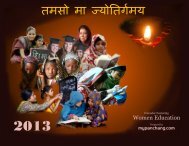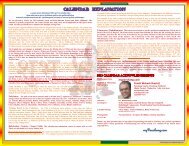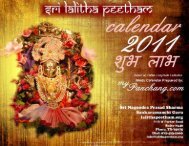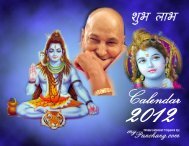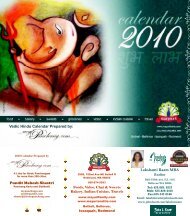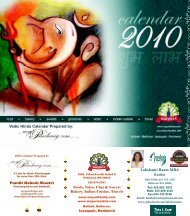Bamboo Garden 2013 Hindu Calendar - myPanchang.com
Bamboo Garden 2013 Hindu Calendar - myPanchang.com
Bamboo Garden 2013 Hindu Calendar - myPanchang.com
You also want an ePaper? Increase the reach of your titles
YUMPU automatically turns print PDFs into web optimized ePapers that Google loves.
Differences in Festival dates between India and USA<br />
Pundit Mahesh Shastriji<br />
Panchang Ganitha and Siddhanta<br />
mypanchang.<strong>com</strong><br />
The Indian <strong>Calendar</strong>/Panchangam is used everywhere where <strong>Hindu</strong> people live. I even see people posting, “ I want pambu Panchangam, but I live in the USA and it is not available”. The question then arises:<br />
“Can Indian Panchangam be used outside of India?”. If you think the Earth is flat then you can use your favourite Indian panchangam/calendar outside of USA. But if you agree with Varahamihira and<br />
Aryabhatta, and other scientiests that the Earth is round then you will not use your favourite Indian panchang/calendar outside of India. Please read why.<br />
People usually align the <strong>Hindu</strong> festivals with the English dates based on the Indian calendar. They then think that if an Indian calendar says “Janmasthami” on a certain date, say September 2 nd 2010, then it will<br />
appear as September 2 nd everywhere in the world. The USA is 10:30 to 15:30 hours behind India, so some people will think it will also <strong>com</strong>e the next day in the USA, i.e. September 3 rd 2010. They also argue<br />
that their family priest in India has told them to celebrate on this particular date and according to him the Indian calendar will apply to all places in the world. This is a <strong>com</strong>pletely wrong assumption.<br />
The English date and day (Sunday, Monday, Tuesday etc..) changes at midnight; whereas the <strong>Hindu</strong> date (or Tithi) and day does not change at midnight. <strong>Hindu</strong> days change at Sunrise. All days are from one<br />
Sunrise to another Sunrise. Sunday will start at one Sunrise and end at the next Sunrise.<br />
The <strong>Hindu</strong> date (or Tithi -- depending on the position of the Sun and Moon at any given time) changes as celestial bodies move. It can change anytime between two Sunrises. That is to say that if Prathama Tithi<br />
ends today at 23:02 it does not mean that Dwitiya Tithi will end tomorrow at the same time. It can end at 18:00, 18:09 or 28:27 (anytime after 24 means after midnight but before the next Sunrise).<br />
Now what's the <strong>Hindu</strong> date (Tithi)? It is simple. A Tithi is a lunar day, or the time it takes for the longitudinal angle between the Sun and the Moon to increase by 12°. Tithis begin at varying times of day and<br />
vary in duration from approximately 19 to 26 hours. So the maximum distance between the Sun and the Moon can be 360 degrees. If you divide them by 12 degrees giving you 30 equal parts. This means that<br />
we have 30 dates in the <strong>Hindu</strong> calendar divided between the bright half (Shukla Paksha, Waxing Moon), and the dark half (Krishna Paksha, Waning Moon).<br />
Panchangam contains two types of calculations. One is based on the local coordinates like longitude and latitude (Sunrise, Sunset, Moonrise, Moonset, etc), and the other is based on geocentric planetary<br />
positions. Sunrise, Sunset, Moonrise, Moonset times are always calculated for each and every place on the Earth. Local Sunrise, Sunsets are used to find the daily Rahukalam, Yamagandam, Gulikai, and<br />
Durmuhurtham times.<br />
The other set of calculations are calculated from the center of the Earth (geocentric). The positions of heavenly bodies are calculated from the center of the Earth and hence they are geocentric. The planetary<br />
positions are first calculated from the center of the Sun (heliocentric) and then using the spherical trigonometry they are converted to the center of the Earth (geocentric). The Tithi, Nakshatra, Yoga, Karana<br />
and daily planetary positions are based on the positions of the Sun and Moon in the heavens and they are part of the astronomical phenomenon. These are astronomical phenomenon which happensinstantly<br />
at the same moment on Earth, and hence the Tithi and Nakshatra will end at the same time all over the world. We have to, therefore, convert them to the local standard time of the specific country of interest.<br />
When an eclipse occurs and is visible all over the world, the time of occurrence is converted into each country’s local time zone. The planets do not wait for Sunrise or Sunset at the particular place. They just<br />
keep moving, like Earth is moving around the Sun.<br />
These planetary positions of the Sun and the Moon are <strong>com</strong>puted based on the local time (longitude, latitude) converted to the Universal Time. The Tithi end time is also calculated in the Universal Time which<br />
is then converted to the local time of the place. The planets are calculated from the center of the Earth and their positions at the given time will be the same all over the world. In the same way, whenever any<br />
celestial event occurs we need to convert it to our local time zone. Indian Panchang makers convert this to Indian time. The same say we need to convert it to our time zone for America (PST/PDT, CST/CDT,<br />
MST/MDT, EST/EDT). After adding the time difference we get the resulting English date and time when they end. Hence, when the calendar is made for India the date they mention is when that Tithi will end<br />
as per the English date in India. If we take the same date and time use it anywhere in the world as it is then we will have wrong results.<br />
For example: On October 17th 2008 the Ashwayuja (Ashwin) Krishna Paksha/ Poornimant Kartik Krishna Paksha Tithi Tritiya ends at 16:39:21 Indian Standard Time, and Charturthi starts. That means at 16:00<br />
hours there is Tritiya still prevailing in India. Now on October 17th 2008 in Seattle, WA at the 16:00 hours we won't have Tritiya at that time. We already have Chaturthi started. Planets keep on moving.... 13<br />
hours have passed and the position of Sun and Moon have changed. So what time will Tritiya end in Seattle? The time difference is 13 hours 30 minutes (with one of our Daylight Saving Time it gives the<br />
difference of 12 hours 30 minutes from IST). So, let's subtract 12 hours 30 minutes from the 16:39:21. That gives us 04:09:21 AM on October 17th. So on October 17th after that time we'll have Chaturthi Tithi<br />
and before we have Tritiya. The same way if Tithi ends at 8:39 AM on Septemer 12 in India it will end at 20:09 PM on September 11th in Seattle. The same way Western Australia is 8 hours ahead of GMT and<br />
hence the Chaturthi will end there at 12:09 PM on September 12th. The planets do not wait for the appropriate Tithi to arrive on some English date at any location in the world. If it did we would not have any<br />
days and nights (if it were to happen then celestial bodies would remain static in sky). The Earth is round and it keeps moving, so we have days and nights. It does not wait for Tithi or festivals. Time never waits<br />
for anyone. It goes on. The Sun does not rise instantly at the same time all over the world. Hence we need to convert the Tithi, Nakshatra, Yoga, and Karana time to local standard time. Now we know what<br />
time a given Tithi ends, so now it is time to decide festival dates for each region.<br />
How festivals are determined? The usual rule to observe a festival for a particular day, check which Tithi prevails at that Sunrise. Each festival has different rules of observance. For example: Ganesh<br />
Chaturthi. Sankathara (Sankshathi Chauth) Chaturthi, Janmashtami, Mahashivaratri, Karwa Chauth, etc... For example Ganesha Chaturthi has to be oserved when the Chaturthi Tithi is observed during the<br />
8th/15th part of the dinmana or the 3/5th part of the dinmana. The dinmana is the difference between local Sunset and Sunrise on the same day. If Chaturthi is not prevailing during that period then take the<br />
second day. Likewise for the Karwa Chauth and the Sankathara Chaturthi the Chaturthi Tithi must be prevailing during the moonrise time, if it does not prevail then take the day where it prevails during the<br />
sunrise. Rules to determine Shraddha Tithi are different.<br />
For example, if one Tithi is observed at moonrise in India it may or may not exist during moonrise on the same day in a different part of the world. It may be very well observed on the previous day if you are in<br />
America or the next day if you are in Japan, Fiji, Australia and other countries. America is behind India in terms of time. To arrive at the time in India we need to subtract the time from Indian time and hence<br />
festivals could arrive a day early in USA but not later. For example if a total lunar eclipse is visible in India at 5:00 AM it will happen on the previous day in the USA.<br />
For these reasons Indian Panchangam you buy in India cannot be used outside of India.





